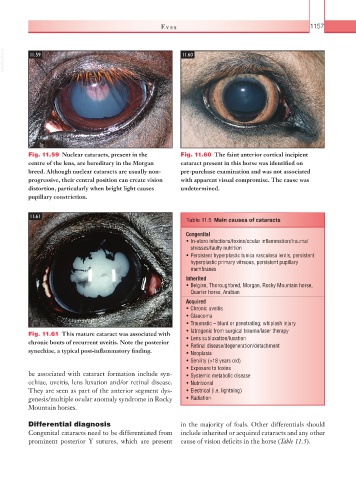Page 1182 - Equine Clinical Medicine, Surgery and Reproduction, 2nd Edition
P. 1182
Eyes 1157
VetBooks.ir 11.59 11.60
Fig. 11.59 Nuclear cataracts, present in the Fig. 11.60 The faint anterior cortical incipient
centre of the lens, are hereditary in the Morgan cataract present in this horse was identified on
breed. Although nuclear cataracts are usually non- pre-purchase examination and was not associated
progressive, their central position can create vision with apparent visual compromise. The cause was
distortion, particularly when bright light causes undetermined.
pupillary constriction.
11.61
Table 11.5 Main causes of cataracts
Congenital
• In-utero infections/toxins/ocular inflammation/trauma/
stresses/faulty nutrition
• Persistent hyperplastic tunica vasculosa lentis, persistent
hyperplastic primary vitreous, persistent pupillary
membranes
Inherited
• Belgian, Thoroughbred, Morgan, Rocky Mountain horse,
Quarter horse, Arabian
Acquired
• Chronic uveitis
• Glaucoma
• Traumatic – blunt or penetrating; whiplash injury
• Iatrogenic from surgical trauma/laser therapy
Fig. 11.61 This mature cataract was associated with
chronic bouts of recurrent uveitis. Note the posterior • Lens subluxation/luxation
• Retinal disease/degeneration/detachment
synechiae, a typical post-inflammatory finding. • Neoplasia
• Senility (>18 years old)
• Exposure to toxins
be associated with cataract formation include syn- • Systemic metabolic disease
echiae, uveitis, lens luxation and/or retinal disease. • Nutritional
They are seen as part of the anterior segment dys- • Electrical (i.e. lightning)
genesis/multiple ocular anomaly syndrome in Rocky • Radiation
Mountain horses.
Differential diagnosis in the majority of foals. Other differentials should
Congenital cataracts need to be differentiated from include inherited or acquired cataracts and any other
prominent posterior Y sutures, which are present cause of vision deficits in the horse (Table 11.5).

